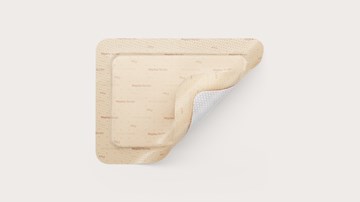Epidermolysis Bullosa (EB)
For people with the incurable skin condition Epidermolysis bullosa (EB), protecting the delicate skin around lesions, addressing the bio-burden and exudate management are all key.

Around 500,000 people
EB can range from mild, where the patient experiences small, reoccurring blisters through to the most severe, where blister also develop in the soft tissues (mucus membranes) inside the body. Eating solid food, for example, can have a devastating effect on the mouth and the oesophagus
Aetiology
Epidermolysis bullosa (EB) is the name given to a group of genetically determined disorders characterised by excessive susceptibility of the skin and mucosae to separate from the underlying tissues following mechanical trauma
The four types of EB are mostly categorised by the level of cleavage at the dermal/epidermal junction
- Epidermolysis bullosa simplex (EBS)– the mildest and most common form. EB Simplex causes blisters at the site of rubbing, typically affecting hands and feet. It affects keratin genes in the epidermis
- Junctional epidermolysis bullosa (JEB)– appearing at birth and generally more severe than EB Simplex, Junctional EB presents with blisters at the site of friction. This type affects laminin and collagen
- Dystrophic epidermolysis bullosa (DEB)– Dystrophic EB can be mild to severe, and it affects the skin and other organs. Dystrophic EB is caused by genetic mutations that affect the production of collagen. In severe forms of DEB there are many complications, which have an impact on the individual’s ability to heal. Common complications are malnutrition, anaemia, recalcitrant pruritus, pain, infection and critical colonisation
- Kindler syndrome – a rare, difficult to diagnose EB condition which is often confused with other subtypes of EB. It is caused by mutations in the FERMT1 gene. Blistering, epidermal atrophy and delayed healing result from FERMT1 gene mutations. Trauma-induced skin blisters occur in early life and are prevalent together with skin loss and wounding during the neonatal period
Effects on patient quality of life
Care for EB patients focuses on managing the condition as EB has no cure yet.
The lives of patients are overshadowed by pain and discomfort – and stress is a constant as they seek to avoid the physical contact that will damage their skin. Many children with EB, who are often called the ‘butterfly children’, are unable to experience the joys of a normal childhood. Patients are frequently hospitalised – and people may miss blocks of education or work if they are unable to fulfil their commitments because of the severity of their wounds and other effects of the condition.
EB affects families too. Their lives can feel dominated by seemingly endless routine of wound managements and medications. Wounds need to be cared for – and blisters pierced, drained and dressed. Bathing and dressing changes can take more than three hours at a time. Pain medications and antibiotics must be administered, and doctors, clinics and support groups attended. All this means that caring for someone with severe EB can be a 24/7 job
Management
With so many wounds at different stages of healing, the management of EB is complex
- Wound dressings - the skin is so fragile and dressing changes so frequent that atraumatic dressings are recommended to prevent further damage, pain or bleeding
. Silicone-based dressings are easier to apply and remove than traditional dressings . They also protect the wound and peri-wound skin and create a favourable environment for wound healing . - Infection management - there is a high risk of infection due to large areas of open wounds. Antimicrobial cleansers, moisturisers and topical treatments are necessary to manage the wound bio-burden
. - Blister management - EB blisters need careful management as they will extend rapidly if left unchecked
. Intact blisters should be lanced with sterile needle at their lowest point to limit tissue damage . Sterile swabs or sponges can be used to gently compress the blister to encourage complete emptying. - Dressing retention - if dressings slip, they can tear the fragile skin and cause the wounds to stick to clothing of bedding
. The dressing should be held firmly in place with a retention bandage. The bandage should not put additional pressure on the wound and it should allow freedom of movement to prevent shearing forces from causing additional blistering . Tubular bandages can be used .
The future of EB treatment
New strategies are being developed to manage EB all the time. While there is currently no cure, there is a focus on studies in stem cell and gene research and bone marrow transplantation as possible future cures.
Related products
'References'








